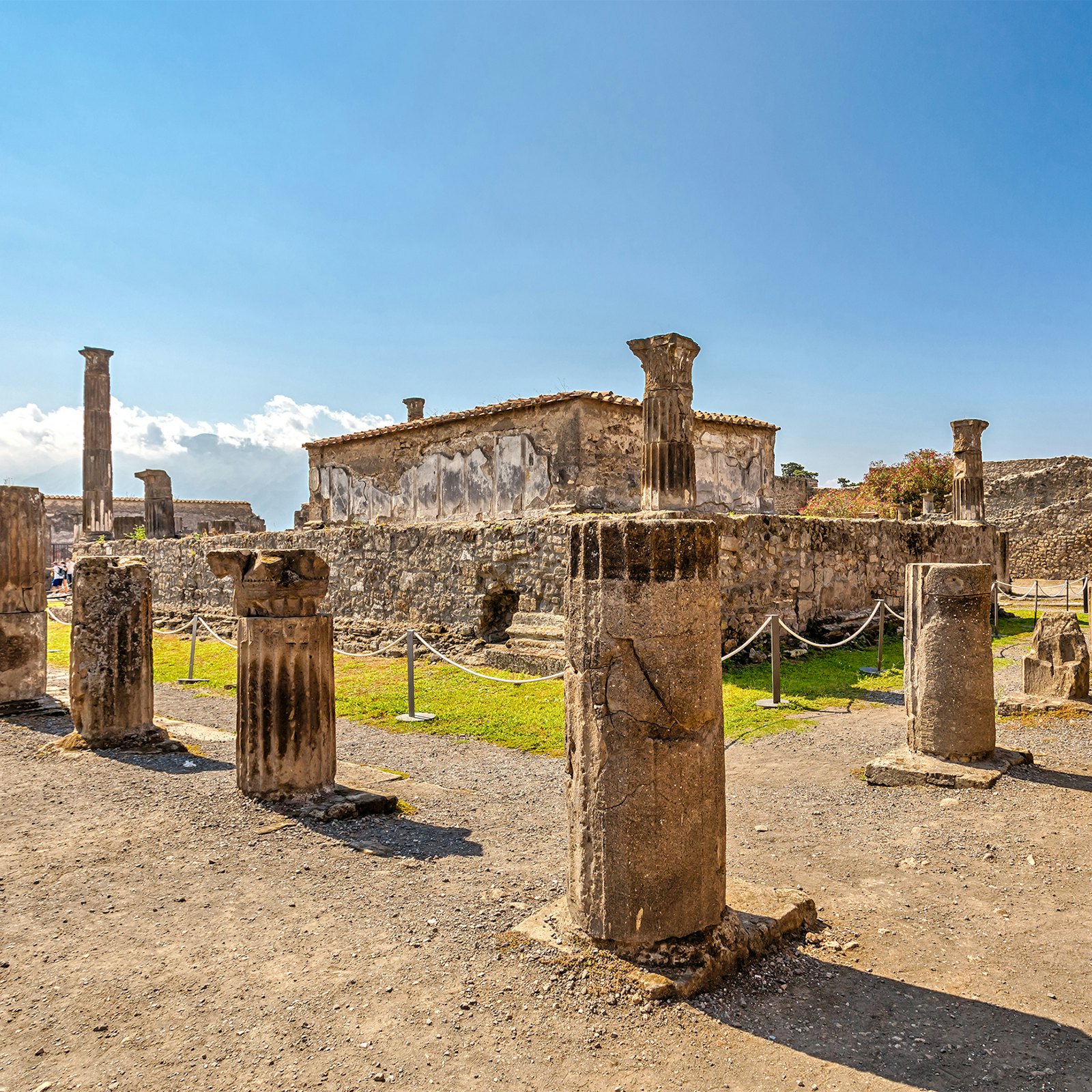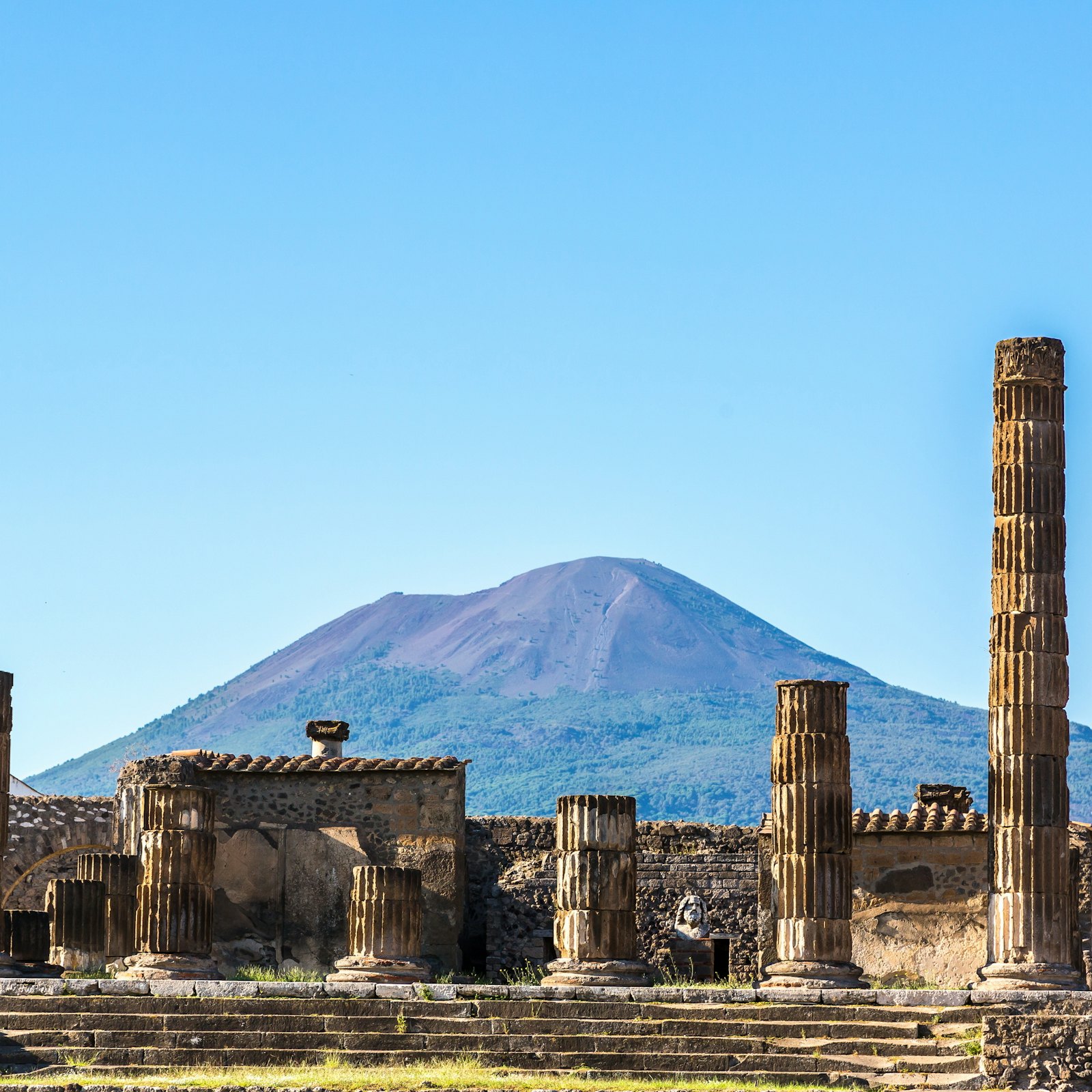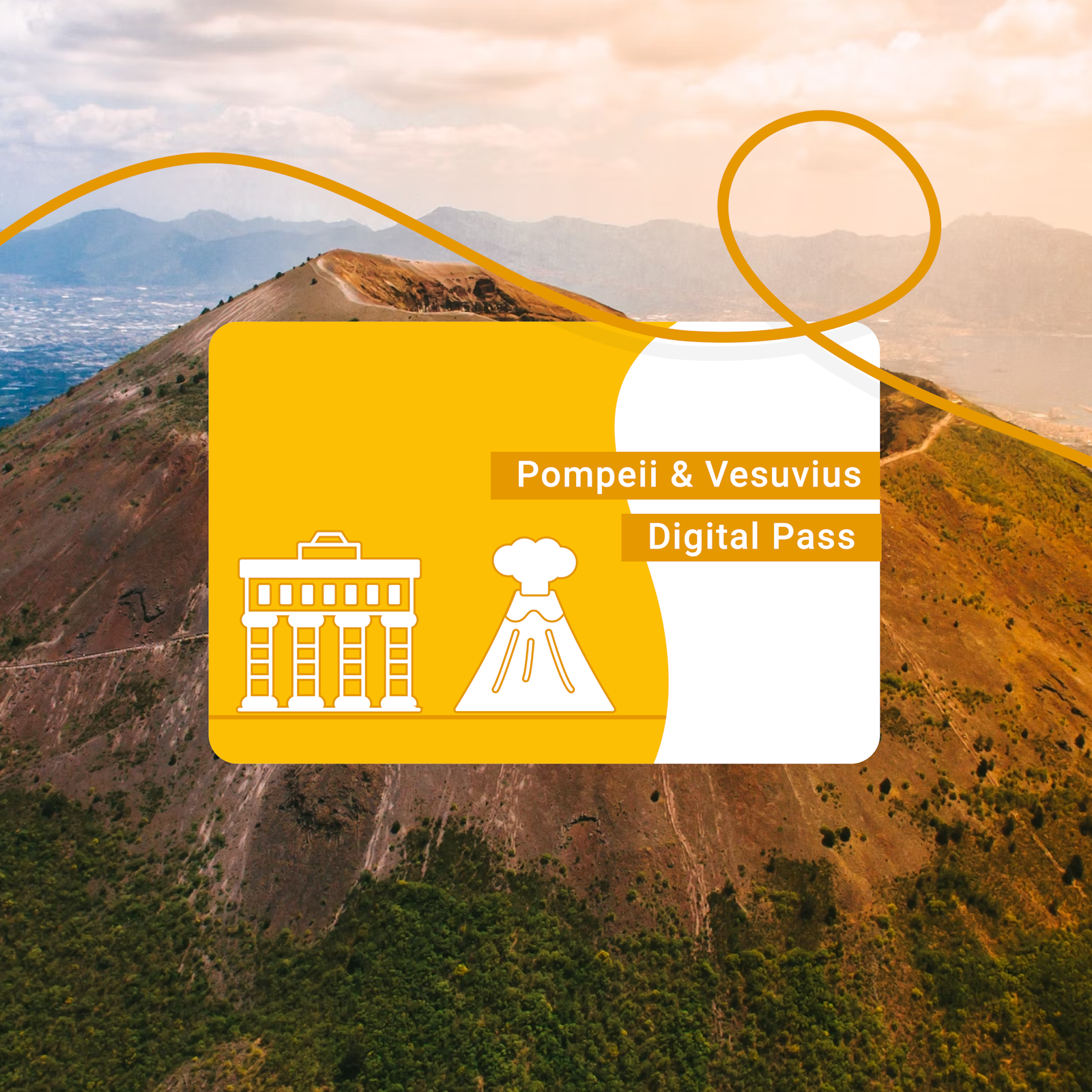Pompeii: Reserved Entrance Ticket
Secure your ticket in advance for one of the world’s iconic archaeological sites
- Pompeii: Reserved Entrance Ticket
- Audio guide of Pompeii (if option selected). Audioguide must be collected in front of Piazza Esedra.

Pompeii & Mount Vesuvius Tickets and Information
- Pompeii Address: Via Villa dei Misteri 2, 80045, Pompei
Are Pompeii & Mount Vesuvius Worth Visiting
- We definitely think so, yes.
- See the city that was frozen in time.
What You See at Pompeii & Mount Vesuvius
- The ancient ruins
- Remnants of artefacts, artwork and buildings
{{ticket-block-triple}}
About Pompeii & Mount Vesuvius
Pompeii and Mount Vesuvius are forever linked by one fateful day in 79 AD. The eruption of Mount Vesuvius is one of the most infamous volcanic events in history that buried the Roman city of Pompeii under layers of ash which preserved it as an archaeological site that is now one of Italy’s major tourist attractions.
Before its destruction, Pompeii was a bustling city with about 20,000 inhabitants. It was established in the 6th century BC, and it became a vital trade hub flourishing under Roman rule. Pompeii was known for its intricate architecture, vibrant markets, and luxurious villas, which symbolised Roman prosperity.
The eruption turned the city into a time capsule. Ash and pumice covered Pompeii, instantly freezing it in time and preserving buildings, artifacts, and even the imprints of its residents who perished in the disaster.
Pompeii remained a mystery for centuries until its accidental rediscovery in the 18th century. It was later brought back to light through continued archaeological excavation efforts. You can see ancient ruins which offer a unique glimpse into the past and imagine the fascinating stories and myths that have intrigued for centuries.
See The Remarkable Preservation. The volcanic ash from Mount Vesuvius preserved Pompeii's buildings in an extraordinary manner. You can see first hand how the natural disaster froze the city in time, providing a remarkably detailed snapshot of Roman life.
Pompeii has an impressive collection of artworks, frescoes, and artifacts. The treasures offer a look at the artistic and cultural achievements of the ancient Romans, which is fascinating to see.
The Eruption of Mount Vesuvius
Mount Vesuvius had been dormant for a long time before its eruption on August 24, 79 AD. When the volcano violently erupted it sent a massive column of ash and debris into the sky and the intense eruption created a pyroclastic flow that went on to bury Pompeii and neighbouring towns of Herculaneum and Stabiae.
The devastation was so significant with layers of ash up to 20 feet deep in some places. The catastrophic event led to Pompeii's disappearance from history until its accidental rediscovery in the 18th century by archaeologist Giuseppe Fiorelli which marked the beginning of extensive excavations.
The digs went on to unveil a remarkably well-preserved snapshot of ancient Roman life with intricate frescoes, well-preserved buildings, and even the remains of its citizens that had been frozen in time and offered unprecedented insights into what was daily life during the Roman Empire until the fateful day with the volcano erupted..
You can explore its preserved streets, houses, and public buildings with highlights including the Forum, the Temple of Apollo, and the Amphitheatre, which offer a glimpse into the city's former glory.
Mount Vesuvius
While Pompeii stands as a testament to the tragedy of 79 AD, Mount Vesuvius itself has also become a fascinating destination. The volcano, which is still active but currently dormant, can be climbed and you can enjoy amazing views of the Bay of Naples and the surrounding landscape from its slopes.
At the summit you can peer into the crater which serves as a constant reminder of the raw power that once devastated Pompeii. The contrast between the serene beauty of the landscape and the volcano's destructive history creates a surreal experience.
Popular Tickets
Popular Attractions
Mount Vesuvius and Pompeii FAQs
- What is Mount Vesuvius?
- Mount Vesuvius is an active volcano in southern Italy, near Naples. It's known for its catastrophic eruption in 79 AD, which buried Pompeii and Herculaneum, the next towns along.
- How far is Pompeii from Mount Vesuvius?
- Pompeii is about 9 kilometres (5.6 miles) from Mount Vesuvius.
- What happened to the people of Pompeii during the eruption?
- Many residents were sadly killed by the pyroclastic flows and ashfall. Their bodies were buried, and some left behind impressions that modern archaeologists have preserved using plaster casts.
- Can you climb Mount Vesuvius?
- Yes, you can hike to the crater of Mount Vesuvius. The trail offers amazing views of Naples and the surrounding region.
- Why is Pompeii so well-preserved?
- Pompeii was buried under a thick layer of volcanic ash and pumice, which sealed and preserved the city for centuries.
- Are there guided tours of Pompeii?
Yes. Click HERE for ticket options. - What is the significance of Pompeii’s frescoes?
- The frescoes provide a vivid glimpse into Roman art, culture, and daily life, including mythology, rituals, and leisure activities.
Mount Vesuvius and Pompeii Interesting Facts
- A Bustling City: Pompeii was a bustling city of about 11,000 people when Mount Vesuvius erupted in 79 AD.
- Active Volcano: Mount Vesuvius is the only active volcano on the European mainland.
- Energy: The eruption of 79 AD released thermal energy 100,000 times more powerful than the atomic bombs dropped on Hiroshima and Nagasaki.
- Preservation: The ash and pumice preserved not only buildings but also food, utensils, and even graffiti in Pompeii.
- Site Digs: In Pompeii, archaeologists found loaves of bread still intact in ovens that were carbonized by the heat.
- More Eruptions: Vesuvius has erupted over 50 times since 79 AD, with the most recent eruption occurring during World War II.
- Volcano: The word "volcano" comes from Vulcan, the Roman god of fire.
- Herculaneum: Unlike Pompeii, Herculaneum was buried under a thick layer of mud, which preserved organic materials like wooden furniture.
- UNESCO World Heritage Site: Pompeii is a UNESCO World Heritage Site and attracts millions to see it each year.
Useful Information About Pompeii and Mount Vesuvius
Tips for visiting Pompeii
- Book Tickets Online: Its easy and convenient to do and can also save you a lot of time as its an incredibly popular attraction.
- Combination Tickets: Look at our range of combination tickets for Pompeii so you can enjoy more than one attraction, for example Pompeii and Mount Vesuvius combination ticket. Click HERE to see options.
- Arrive Early: Pompeii is a popular destination and it can get very crowded, especially during peak seasons. Arriving early in the morning not only helps you avoid the crowds but also allows you to explore the site during the cooler part of the day.
- Wear Comfortable Clothing and Footwear: The ruins of Pompeii cover a large area, and you'll be doing a lot of walking on uneven, ancient stone roads. Comfortable shoes are a must.
- Bring Water and Snacks: There are limited facilities within the archaeological site, so it's a good idea to bring your own water and snacks. Staying hydrated is important, especially when you're walking around in the heat.
- Consider a Guided Tour or Audio Guide: Pompeii is vast and rich with history. Opt for one of our guided tour tickets as the guide can give you more information and provide further insights.
How To Get to Pompeii
- Pompeii, Via Villa dei Misteri 2, 80045, Pompei
Opening Hours - Mount Vesuvius
- Monday: 09:00 - 15:00
- Tuesday: 09:00 - 15:00
- Wednesday: 09:00 - 15:00
- Thursday: 09:00 - 15:00
- Friday: 09:00 - 15:00
- Saturday: 09:00 - 15:00
- Sunday: 09:00 - 15:00
Opening Hours - Pompeii
- Monday: 09:00 - 17:00
- Tuesday: 09:00 - 17:00
- Wednesday: 09:00 - 17:00
- Thursday: 09:00 - 17:00
- Friday: 09:00 - 17:00
- Saturday: 09:00 - 17:00
- Sunday: 09:00 - 17:00





























